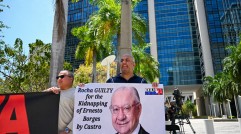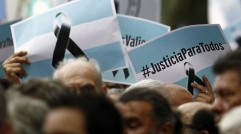Metropolitan Opera Review 2014-15: Marcelo Alvarez Leads Excellent Cast in "Cavalleria Rusticana & Pagliacci"
Doing a double-bill production is a truly difficult task.
The approach for taking on two different works in one evening can vary from connecting the works thematically, visually or finding two different languages for each work. The latter approach is by far the more complex and could lead to insightful results based on contrast or disastrous unevenness produced from one work dominating the other.
"Cavalleria Rusticana" and "Pagliacci" represent the ultimate double bill in all of opera and present some unique challenges in staging. The works, despite belonging to the Verismo genre of opera, have little in common in regards to their dramatic movement or characters. Themes of lust and adultery certainly connect the works, but "Cavalleria" certainly plays as a more watered down drama when compared to "Pagliacci's" complex look at life and theater as one. Many times directors look to connect the worlds of both operas visually or thematically. Rarely do they go for major contrast.
Sir David McVicar is a highly-respected director who on the surface has seemingly gone for this approach, but on further analysis has actually followed a different approach -- work diligently on one and then throw the leftovers at the other one. One could argue that the Metropolitan Opera's other double bill this year, "Iolanta" and "Bluebeard's Castle," suffered a similar fate, but even then there were visual elements that ultimately connected both works on a far deeper level.
In the case of this double bill it becomes increasingly clear that "Pagliacci" was the one that resonated most with the director and that "Cavalleria" was a necessary obstacle to overcome to get to the ultimate goal. The two productions could not be more different, united by one single visual element that contrasts in its use. But unfortunately the contrasts only highlight the superiority of the conception for Pagliacci. Leoncavallo's work is filled with color and great contrast while Mascagni's is draped in black on every imaginable level (set background and costumes). "Pagliacci's" chorus members move around with a purpose; one is troubled to figure out what exactly "Cavalleria's" chorus members are doing running around from one moment to the next. Even choreographed material is fumbled in one work while cleverly staged in the other. McVicar has dancers throughout both productions, but in "Cavalleria" one struggles to find the motivation. Meanwhile the trio of Vaudeville dancers in "Pagliacci" add tremendous comedy worthy of the opera's name.
And then there is the turntable. In "Pagliacci," the device gets used a handful of times and every turn has a purpose. It is leading the viewer somewhere, often to a new perspective of the stage. But in "Cavalleria," it seems that McVicar overused the turntable because he had it and did not feel like wasting the tool. Or more problematically, because of a mistaken sense that movement adds visual variety on set. Usually it turns when there are major choruses, but it leads the eye nowhere. One can liken the use to modern Hollywood directors who move the camera around to add energy and momentum to a shot with no care for the why of the movement; but in doing so they often lose a sense of purpose and impact. In this case, the audience becomes numb (or nauseous) to the turning table, making it a frustrating part of the evening to endure. More disconcerting is that aside from turning the table incessantly, McVicar has no other major visual ideas for "Cavalleria."
Not all is horrid, however, and credit must be given for some effective gestures. There is a raging battle of the sexes throughout that highlights the main conflict between Santuzza and Turridu. Santuzza is always on stage and even when she is not singing she often relegated to stage-right/ audience-left, emphasizing her falling from the grace of God. McVicar clearly has a point-of-view on his dislike for Turridu and Lola, making them abusive villains with little to no compassion for the heartbroken Santuzza. Turridu throws her to the ground and constantly abuses her verbally and physically. This of course makes his final moments, in which Mascagni clearly wants the listener to empathize with him, less effective. But it does place a greater importance on Santuzza's role in the drama.
And this of course only highlights the more balanced attention given to the characters in Pagliacci, with each commanding the viewers' attention and empathy.
Leading the cast was Argentine tenor Marcelo Alvarez, who took on the admirable task of the double bill. Alvarez can be frustrating in this repertoire and his work in these operas highlights the numerous pros and cons of his style. His middle register has a sunny and weighty timbre that suits this dramatic style. But his voice thins out in the tenorial stratosphere often leading to passages where the color shifts are inconsistent and even buried under massive orchestration. At other times we hear Alvarez's trademark phrasing in which he cuts off his voice, takes a breath and then pushes out the high note; the phrasing becomes choppy at the expense of the ringing high note. Rarely do you hear the tenor connect the color from one register to the other consistently.
But there can be no doubt of the enthusiasm and passion Alvarez has for this repertoire, particularly in Pagliacci where he delivers a more complex reading of Canio. He certainly comes off as an awkward man with alcoholic and violent tendencies that only grow and develop throughout the night. His singing of "Un tal gioco, credetemi" started with cool and collected singing while slowly building into a soaring high note that exploded with rage.
When he chases after Silvio and then returns to pursue Nedda, there was a restraint in his approach, as if he knew that any action he took would be a fatal one. It certainly added a gentler dynamic to Canio, highlighted in Alvarez's reading of the famed aria "Vesti La Giubba!" From the opening phrases of the iconic passage, Alvarez sang with milder tone, making for the crescendo to Canio's remorseful "Ridi Pagliaccio" all the more intense and vibrant. At this point, McVicar signals in one of his finest directorial touches, having Canio move from the world of the opera to downstage where he winds up in front of the theatrical curtain. This connects him visually with Tonio and his opening narrative in which he promises to show people that laugh, cry and suffer like the audience members. And in this moment, Canio fulfills that promise and becomes yet another everyman suffering passions that many others endure.
Alvarez was subdued in the violent climax; his immobility juxtaposed with the more active performance of Patricia Racette's Nedda. But his pianissimo singing "Sperai, tanto il delirio" pulled the listener in, Canio's suffering brought to its greatest intimacy and delicacy. Here was a man who in his most violent rage was completely broken and pleading for a way out of his horrid destiny. The eventual murders are among the most potent moments of the entire evening, with Nedda's death coming as a shock to the audience on stage and Silvio's a savage beat down preceded by Alvarez's dehumanized call of "Ah! Sei tu! Ben venga!"
In "Cavalleria," Alvarez really relished the villainy of Turridu, making him a reckless hothead with little compassion for the woman he was abandoning. There were a few moments in their famed duet in which he would prop her up off the floor, but they were quickly followed by more violence. The final aria, "Mamma. Quel vino e generoso" was sung with all of his vocal resources. He did a wonderful job of juxtaposing Turridu's passionate pleas to his mother with the restrained moments in which he does his best to hide the situation from her.
The two leading ladies on the evening, Eva-Maria Westbroek and Patricia Racette shone brightest for differing reasons. Because of the production, Westbroek's Santuzza spends most of the evening on the floor or on the audience left, thus limiting her effectiveness as a complex character. But Westbroek dives into the suffering, her voice singing ardently and powerfully the entire evening. Her prayers rise wondrously above the Easter chorus and in her duets with Alvarez, Westbroek soared over him, a battle of wills that added tremendous tension to the scene.
Racette gets more to do, mainly because her Nedda is treated with greater dynamism. She is not an ingénue, but a world-weary middle-aged woman, making her protests of her current life with Canio credible and understandable. But she knows her role and is constantly playing up her sexuality both in front of the fans and onstage. But when she is finally left alone, Racette's Nedda is a more subtle woman dreaming of soaring away to freedom with the birds. During that famous aria "Qual fiamma aveva nel guardo!" her rich- (if sometimes sharp) and granular-toned voice soared with a intense desperation. The journey to the euphoric climax "E van... E van" was rapturous with every phrase growing in strength and energy. There was a tremendous sense of strength emanating from the character, further highlighted by her standing on the car with her hands spread out. In the ensuing duet with Silvio, Racette's sense of passionate strength was quieted down and a guilt overtook at key moments. But when she was eventually won over, she jumped into the love affair with no abandon and one of the most explicit sex scenes at the Met ensued.
The final moments of the opera were arguably her most dynamic with Racette's Nedda constantly jumping between her sense of enjoyment and a growing frustration with Canio's violent demeanor. When Nedda finally fights back, the work's emotional climax, Racette let her voice go with complete emotional abandon, her sense of strength as potent as Alvarez's rage. It completed an arc of a woman looking to break free from her oppressive captor. Her fate is tragic, but her ultimate emotional state finds its significance.
George Gagnidze took on the two roles of Silvio and Tonio and showcased arguably his best work at the Met in his career. His voice has a rather arid color, but it suited the rugged Silvio and deformed Tonio wonderfully. In Silvio's opening aria, his vicious accents on consonants defined a man filled with violent potential that was realized when he hurled Santuzza to the ground after an inflamed duet between the two.
As Tonio he was far more nuanced, his opening aria filled with a delicate prying of the audience. There was a hesitancy that hinted at what was to come with his deformed Tonio but when he arrived at the lush "E voi, piuttosto" his voice soared to glorious heights, the high notes ringing throughout the theater with unbridled passion. During his famous scenes with Nedda, he came off as an awkward fellow (almost a shadow to Canio), but sang with heartfelt intimacy as he expressed his love for Nedda. There was nothing threatening in his singing in these moments. Of course, like Canio, he turned on the violence at the apex of the scene. At the close of the evening, Canio usually gets to utter the famed "La commedia e finita," even though Leoncavallo actually gave the line to Tonio. In this production, McVicar makes the choice to allow Tonio the honors and Gagnidze delivers a horrified and pained outcry of the line, ending the evening on a wrenching note.
Lucas Meachem was a passionate Silvio, his silky baritone providing a great counterpoint to the more rugged sound of Gagnidze's deformed Tonio. Likewise, Ginger Costa-Jackson's flirtatious Lola sang delicately and enticingly, making it clear why she was more attractive for Alvarez's Tirridu.
Andrew Stenson sang with elegant phrasing as Beppe while Jane Bunnell's Mama Lucia developed from scornful and dismissive towards Santuzza to loving and caring.
A word for Canio's troupe which included Marty Keiser, Andy Sapora and Joshua Wynter. As noted, they filled the evening with numerous stunts that added hilarity to a most tragic of works. Their stunts were jaw-dropping, including a moment where they all stood on top of one another and even carried one another around.
And where would this all be without Fabio Luisi and the Metropolitan Orchestra. Every single note, from start to finish, was precious. In the opening prelude, there was a generous contrast between the intimacy of the winds and then the violins' piercing entrance. The famed intermezzo was quiet and gentle, bringing the listener into an angelic aural world. And the basses that preceded Canio's "Vesti la Giubba," and the ensuing intermezzo, were aggressive and oppressive.
Luisi had no qualms about pushing the orchestra's sound to its most potent limits and, in doing so, he often got some of the most passionate emotional responses from his singers who responded in equal measure.
Musically, this double bill of "Cavalleria Rusticana" and "Pagliacci" was excellent through and through. And from a visual perspective, the latter work was certainly worth the price of admission. However, there is still a lot to be desired from the Mascagni opera, which makes this night somewhat of a letdown.
Subscribe to Latin Post!
Sign up for our free newsletter for the Latest coverage!














